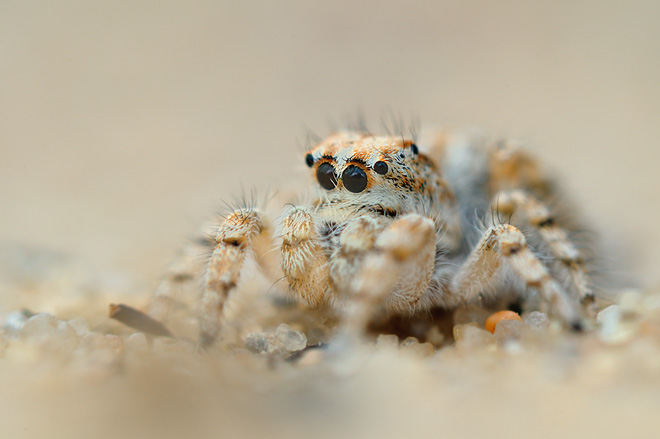Many people are aware that spiders, like virtually all invertebrates, are ectothermic (cold blooded in the vernacular) and prefer warm weather, humid environments and places with lots of readily available food. What many people are not aware of however, are the strange exceptions to each of those "rules." In this post, we will discuss a few of the weird and wonderful exceptions to the normal spidery rules that some salticids have learned to flaunt.
So cold.
Up first is the cold-defying Himalayan salticid (Euophrys omnisuperstes). While very little is known about this species, it is thought to be one of the highest known permanent residents on Earth. Living at an astonishing 6700m up, this spider can be found on the sides of Mount Everest. Never a warm place, this spider has somehow adapted to living in the extreme cold of high altitude. Whats even more amazing is that most of its food seems to be transient insects that are brought to the mountain side by the wind. For a few very nice pictures and some neat footage of E. omnisuperstes, please visit the Arkive website.
I need a drink!
Something that took me a while to really process is that not all deserts are warm. In fact, some of the driest places on Earth are very cold. Thus, this next group of spiders, those who live in very dry (arid) environments can be found in scorchingly hot places like the Arizona desert, to the arid beaches of Sweden. There are many species of salticid that have adapted to these climates, but they all have one thing in common: they have evolved a mechanism (or mehcanisms) for surviving in very harsh, dry environments. In other words, just because the popular perception of spiders decrees that spiders are mainly found in tropical and/or humid areas does not mean that they are absent from more arid regions of the world. Habronattus and Phidippus are both good genera to start researching if you would like more information on these dry climate predators.
I'm 700...
days old. Ok so its not exactly Yoda (900 years old at death), but for a salticid 700 days is practically forever. Most salticids are thought to live for one breeding season and then die (< 365 days total). However, members of the species Yllenus arenarius can 720 days for males and 750 days for females, putting the well above the average life span for a salticid.
 |
| http://www.digitale-naturfotos.de/galerie/images_springspinnen/big/mg2058-duenen-springspinne-yllenus-arenarius.jpg |
Silk free!
One common misconception about spiders, is that all of them build webs. Ironically, I have run into people who know that salticids do not make webs who then reached the erroneous conclusion that they do not produce silk. This is entirely untrue! Salticids make silk, like any other spider. A few even, make webs though this is very rare for the family. So if they don't make webs, but do make silk, what is it used for? Easy, bungie cords!
 |
| An artists rendering of a salticid in mid-jump. Notice the drag line laid behind the spider for safety! |
Salticids are an amazing, diverse, and above all unique group of spiders. It is no surprise that they have developed the aforementioned, and other, exceptions to the usual rules of spider behavior and adaptation. So, the next time you're out spidering, keep an eye out for salticids in unusual places. You might even find something new and unexpected!
No comments:
Post a Comment